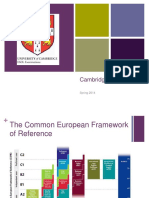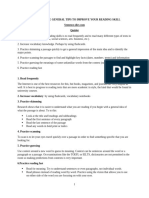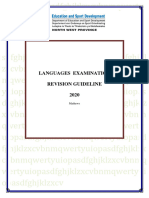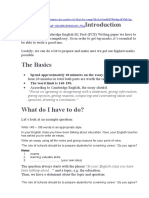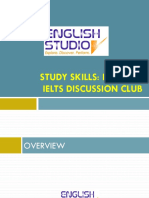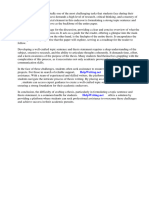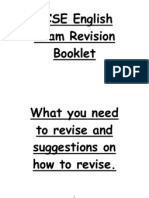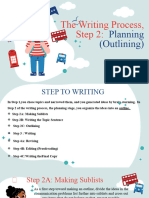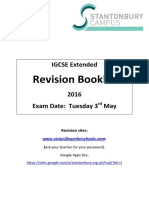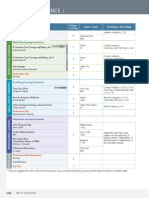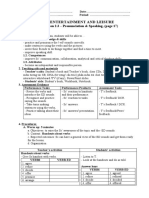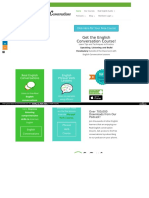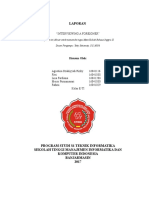March 2020 English HL Holiday Intervention Programme
March 2020 English HL Holiday Intervention Programme
Uploaded by
Kievashan ArmoganCopyright:
Available Formats
March 2020 English HL Holiday Intervention Programme
March 2020 English HL Holiday Intervention Programme
Uploaded by
Kievashan ArmoganOriginal Title
Copyright
Available Formats
Share this document
Did you find this document useful?
Is this content inappropriate?
Copyright:
Available Formats
March 2020 English HL Holiday Intervention Programme
March 2020 English HL Holiday Intervention Programme
Uploaded by
Kievashan ArmoganCopyright:
Available Formats
ENGLISH HOME LANGUAGE
100 MARKS
PAPER 1: COMPREHENSION, SUMMARY AND LANGUAGE
Q 1 COMPREHENSION (11 MARKS)
Q 2 SUMMARY (07 MARKS)
Q 3 ADVERT (05 MARKS)
Q 5 CARTOON (05 MARKS)
TOTAL: 28 MARKS/70 = 40%
Educators should aim that every learner gets at least 40% for Paper 1 using
the above as a guideline.
JUNE 2019 QUESTION PAPERS HAVE BEEN GIVEN TO ALL SES’s SO THAT
THE MEDIATION OF THE WORK AS SUGGESTED HERE CAN BE DONE TO
PREPARE LEARNERS FOR THE EXAMS.
SECTION A: QUESTION 1
COMPREHENSION SKILLS TO BE REVISED
Comprehension is the decoding and understanding of spoken, written and visual texts.
Comprehension skills are not only for the classroom, but are life skills that need to be
developed. Learners first learn to read, later they read to learn.
Guidelines to assist learners in reading for meaning: (Consider doing this step by step
with the learners)
1. Read through the passage quickly.
Get an outline or a general picture of the passage.
Try to picture what you are reading. This helps you to focus and read for
meaning.
2. Take Note:
The title may offer a clue to the contents and purpose of the passage.
The author may help you to identify the time, style and often the subject.
The introduction often creates the atmosphere and provides the setting for what
is to follow.
The conclusion usually ties up the intention of the author.
3. Learners should ask themselves these questions:
Who - is the writer? Who are the characters?
What - is the main idea of the passage?
Where - does it take place? (Setting)
When - does it take place? (Setting – Time, Date, Era)
Why - has this passage been written? What is the writer’s intention?
MARCH 2020 ENGLISH HL INTERVENTION PROGRAMME Page 1
How - does the writer express himself? What language devices are
used?
4. Read through the comprehension questions:
When you do this, keep the passage in mind.
This will give you clues leading to the answers in the passage.
Many teachers and learners prefer reading the questions before reading the
passage.
5. Read the passage again
This time you should be aware of what has been asked.
Highlight the main idea in each paragraph – each paragraph presents a
new idea.
The first sentence is often the key sentence.
Words and ideas that were at first confusing or difficult, may now become
clearer in context.
The more familiar you are with the passage, the easier it should become
to interpret and understand what you are reading.
Practical Advice
Each question usually contains a question word – underline this.
Each question usually contains a key word or key idea – circle this.
Try to remember whether you read this fact near the beginning, middle or end of the
passage.
Put your eyes into ‘Search Mode’ and look down the middle of the paragraph to find
the sentence containing the key word or key idea. Read the whole sentence in
order to get a complete picture.
Do not copy directly from the text but refer to it in order to avoid careless factual of
spelling mistakes. (This applies particularly to names, places, dates or other relevant
information.)
If you are asked to supply a synonym or an antonym:
a. Replace it with the same part of speech e.g. a noun with a noun, an adverb with
an adverb.
b. Take the word that you have chosen back to the passage. Replace the original
word with this synonym and see if it is appropriate.
Answering Techniques:
It is important to interpret and follow the instructions exactly as they are given:
Does the answer need a full sentence, a word or a phrase?
Avoid starting sentences with conjunctions such as because, and, but and so.
The mark allocation is usually a suggestion of the number of points needed.
Your numbering must correspond to the numbering of the questions – if the
number is 1.1.1 you must not answer 1 or A.
MARCH 2020 ENGLISH HL INTERVENTION PROGRAMME Page 2
If you are asked to describe in three sentences what the character looks like, do
not give two or four.
Do not give one word answers if you are asked for a sentence.
Each answer must be written on a new line.
When quoting from the text, enclose the quote with “inverted commas”.
When asked to describe the tone of any text, use one adjective.
Edit your work to check that you have answered correctly. Spelling and
Language errors result in an unnecessary loss of marks.
Write clearly and neatly to avoid possible discrepancies.
SECTION B: QUESTION 2
SUMMARY
Summarising is how we take larger selections of text and reduce them to their bare
essentials: the gist, the key ideas, the main points that are worth noting and
remembering.
Summary skills equip you to find the most relevant information in a passage and reproduce it
in another format.
This skill will equip you to study better in all subjects and to read with a purpose.
Summarising teaches you to be brief and get straight to the point.
The exercise of summarising forces you to analyse and simplify your material.
Summary writing goes hand in hand with analytical skills. With practice, both techniques will
benefit.
What Are We Doing When We Summarize?
We strip away the extra words and examples. We focus on the heart of the matter. We try to
find the key words and phrases that still manage to capture the meaning of what we've read.
We are trying to capture the main ideas and the crucial details necessary for supporting
them.
What do you have to do to get full marks in the summary?
Step 1: Identify the topic you have to summarise.
Read the instructions very carefully. Identify the topic of the summary and write it in big
letters above your planning page.
Step 2: Read the passage with the topic in mind.
Now that you know what to focus on, read the passage once, keeping the topic in mind.
Step 3: Ask yourself: "What can I leave out?”
MARCH 2020 ENGLISH HL INTERVENTION PROGRAMME Page 3
Use a pencil. Read each sentence in the passage and ask yourself, does this have anything
to do with the topic? If your answer is yes, then leave the sentence, if your answer is no,
cross out the sentence.
Step 4: Look at the sentences that you are left with and find the main idea.
Write down the remaining points in short hand on your planning page, double checking that it
is linked to the topic of your summary.
Tricks:
Ignore unnecessary or trivial information.
(E.g. who cares if the house is yellow, if the rest of the details are about firemen rescuing
the family from the burning house?)
Create one category name for lists of items.
(E.g. Substitute the word "family" for the words: mom, dad, brother, sister, cousin, etc.)
Substitute an overall term for components of an action.
(E.g. Substitute, "They finally went to school." for "They went down the walk and got in
the car, they drove down Elm Street and made a right on Oak Street, they could see the
school ahead of them. The car pulled up to the front of the building, and they scrambled
out of the car. They were at school as last."
Remember the magic words: Who, What, When, Where, Why, and How! Answer only
them!
Step 5: Say it in your own words.
When you decide you have captured all the main ideas on your planning page, use your own
words to restate the main idea without changing the meaning. It will help you check your
understanding and keep you from simply copying or plagiarizing.
Step 6: Count your words.
After you have completed your final summary, cross out your planning clearly and count the
number of words that you have used in the final essay. Be accurate in your count.
How to simplify sentences:
Eliminate the following:
Repetition (she is a stunningly beautiful gorgeous girl – she is a beautiful girl.)
unnecessary detail (The tall dark man with a white coat told me to go to school -
the man told me to go to school)
figures of speech (He was a big as a house – He was big)
Quotations
Minor detail
Examples or illustrations
Colloquialisms and slang
Change direct speech to indirect speech.
Make sure your summary is logical.
Guidelines for writing a summary of a text.
MARCH 2020 ENGLISH HL INTERVENTION PROGRAMME Page 4
1. Skim through the text for the main idea.
2. Re-read the text carefully, to understand its purpose and structure.
3. Underline the main points that support the central idea (topic sentence) and circle
statements (linking words) that show movement from one point to another.
4. Decide what you are going to include in your summary and what you are going to
leave out.
5. Write an outline. Group the essential information and ideas – main points and sub-
points – in an order that shows the relations of the ideas. It doesn’t have to be the
same order in which the ideas are presented in the article.
6. To keep the same the same emphasis as that of the original text.
7. Use your own words, but do not introduce your own opinions (unless asked for).
8. Remember that the summary should be considerably shorter than the original
text (about one third). Avoid giving examples e.g. instead saying mum, dad, sister,
cousin, brother etc. your simply say, my family.
9. Revise and “polish” your summary and check that you have covered the whole
text. Be consistent with the tenses – the present tense is the most common.
10. Identify the author and the title.
11. Useful words: to refer to what the author says, e.g. says, states, discusses,
suggests, argues, believes, asserts; to express the author’s development of ideas,
e.g. begins, continues, goes on to, concludes.
SECTION C:
QUESTION 3: ADVERTISEMENT
Key-words: Target market, Logo, Slogan, Copy and Graphics
Give learners the typical exam question and without explaining ask learners to
read the advertisement and answer the questions.
After the learner has answered the questions, mark the answers with the
learners. It is important that the learners see that their visual literacy skills
need attention.
Work through the content notes with close reference to the advertisements
that they have answered at the beginning of the session. Work through the
notes steps by step.
MARCH 2020 ENGLISH HL INTERVENTION PROGRAMME Page 5
LEVI'S 505 JEANS.
NO ORDINARY
FLIGHT OF FASHION
Call them a fashion classic, if you like.
Just simple, honest, 100% cotton jeans that never wear out their welcome.
Never? No, never.
Even that comfortable fit grows friendlier with every wearing.
Pre-shrunk, zipper fly, Levi's 505's. Timeless. Dependable.
Uncomplicated.
Sometimes, don't you wish everything was a little more like that?
Available in Petites, Juniors, Misses & Women's Sizes.
505
LEVI'S
Quality never goes out of style
Nothing
Nothing is accidental in an advert.
The visual first attracts your eyes at an emotional level, in this particular case, the
tall silhouette of this slender girl, which you will follow upwards (regardless of your
gender as a viewer) until you reach the next step.
The flight of birds in the sky is obviously both visual AND textual information. Its
direction leads your eyes to the left, not accidentally again in a US-made ad referring
to a product whose history is closely imbricated to how the West was won.
© Gauteng Department of Education
The next step is the catch phrase, whose graphic structure is also of a visual
nature, and whose meaning is sufficiently enigmatic to make the viewer-reader want
to explore further down.
MARCH 2020 ENGLISH HL INTERVENTION PROGRAMME Page 6
The copy, in smaller type —to make us look closer— is carefully crafted, usually by
a team of professional writers. It addresses the reader personally, almost intimately,
makes her/him a close friend. This speaks to our intellect.
The product logo is obviously again of both kinds, as is the brand name.
Finally, the best line leaves an ultimate subliminal message printed in the viewer's
mind.
In other words, this approach has led the potential client from an emotional or
aesthetic sensation to a more intellectual comprehension of the message. The
advertising experts have moved us from viewing to reading, the better to seduce us.
QUESTION 5: CARTOONS
A cartoon is usually a humorous drawn picture of a situation, well-known personality
or story. Cartoons are used to express ideas or to draw attention to a situation or a
well-known personality.
Cartoons can be more than just light-hearted fun; they often reflect social trends or
highlight serious issues.
A clever cartoon can have more impact than a whole article on the same subject as it
can succinctly capture the essence of the issue.
WHEN STUDYING CARTOONS LOOK AT:
Body language: the positioning of a person that provide non-verbal clues
about their mood and attitude.
Caricature: features or actions of a person are exaggerated to help the reader
work out who is being represented. E.g. Nelson Mandela may be drawn in a
Madiba shirt or Prince Charles may be drawn with big ears.
Intention: what is the cartoonist trying to achieve? Is the cartoon meant to
amuse, make a political statement, or ridicule someone?
Speech bubble: Or a line between the speaker and the words to indicate who
is speaking.
Thought bubble: look like clouds – indicate unspoken thoughts.
Caption: title, brief explanation or comment accompanying and illustration.
Comic strip: sequences of drawings telling a humorous or adventurous story –
found in newspapers, etc.
Frame: one drawing in a comic strip.
Movement: indicated by means of vertical, curved and diagonal lines. Speedy
action is indicated by streaky lines, or by the action going out of the frame.
Punctuation: clever use is made of punctuation to create meaning.
Stereotypes: An exaggerated preconceived generalisation about the typical
behaviour, attitudes, dress, etc. of various types of people.
Verbal clues: some parts of the drawing may be used to help the reader
establish what the cartoon is about.
MARCH 2020 ENGLISH HL INTERVENTION PROGRAMME Page 7
Visual metaphor: in a metaphor two things are compared. In a visual
metaphor, a picture stands for or represents something else.
Irony: When one thing is said, but something else is meant.
Parody: An imitation of a piece of writing used to ridicule the original or create
a satirical point.
Satire: Uses humour to make a serious point. It involves using wit, irony or
sarcasm to highlight human vices or follies.
Look at the following cartoon. Discuss the visual clues that you notice in the cartoon – as it
was done in the previous cartoon.
MARCH 2020 ENGLISH HL INTERVENTION PROGRAMME Page 8
Cartoonists use a number of techniques to communicate sound, movement and emotion.
The illustrations are from the Tintin books.
Example 1:
Motion lines, springs, crumpled clothing ... denote
movement
Squiggles,
Jaggedstars,speech
body language, facialfont
bubble, large expressions,
... denoteshat
sound and
popping emotion
off ... denote emotion
Exaggerated
Motion font ... denotes
lines, springs,sound and emotion
exaggerated body language ...
denote movement
Beads of sweat, facial expressions ... denote emotion
Example 2:
Flames, clouds of steam, vivid colour,
raised eyebrows, lightning bolts ... denote
emotion
Example 3:
MARCH 2020 ENGLISH HL INTERVENTION PROGRAMME Page 9
Punctuation marks, facial expression, springs ...
denote emotion
Speech bubble ... denotes sound
Motion lines, impact explosion, stars ...
denote movement and sound.
Example 5:
MARCH 2020 ENGLISH HL INTERVENTION PROGRAMME Page 10
Lightning bolts, torn clothing, placement
of characters ... denote movement and
sound
Example 6:
When analysing a cartoon, it is important to look at the following aspects:
Actions:
What is happening in the cartoon?
How is the action portrayed?
Characters:
What emotions are communicated through facial expressions?
What actions and emotions are communicated through body language?
What does the body language suggest about the relationships between characters?
Language:
What words have been used?
How has punctuation been used to suggest emotion?
Setting:
Where and when is the cartoon set?
What is the particular social context?
Stereotypes / Symbols:
Has the cartoonist made use of stereotypes?
Has the cartoonist used any symbols to represent something else?
MARCH 2020 ENGLISH HL INTERVENTION PROGRAMME Page 11
PAPER 2 : LITERATURE
SECTION A: POETRY (12 MARKS)
SECTION B: NOVEL (10 MARKS)
SECTION C: DRAMA (10 MARKS)
TOTAL: 32 MARKS/80 = 40%
Educators should aim that every learner gets at least 40% for Paper 2 using
the above as a guideline.
SUPPLEMENTARY 2017 AND JUNE 2017 QUESTION PAPERS HAVE BEEN
GIVEN TO ALL SCHOOLS SO THAT THE MEDIATION OF THE WORK AS
SUGGESTED HERE CAN BE DONE TO PREPARE LEARNERS FOR THE
EXAMS.
TOPIC: CRITICAL ENGAGEMENT WITH A LITERARY TEXT
It is important that as you prepare for the Literature examination that you understand the
language of literature as this provides you with:
a language for interpreting and deconstructing texts
for conveying information
for critically engaging with the texts
for interpreting characters’ actions and intentions
for understanding of setting, plot and development of plot, themes, role of narrator
for understanding irony and dramatic irony
for understanding the role of the director in the dramatization of a drama and how this
adds and enhances the plot and the role of the characters.
LEARNERS’ ACTIVITY:
Before beginning with this activity, ask yourself the following questions:
MARCH 2020 ENGLISH HL INTERVENTION PROGRAMME Page 12
Have you read the text and are not relying only on a film version of the novel or the
drama?
Do you have a full understanding of the terminology used in reference to the novel
and the drama, e.g. setting, plot, themes, irony, dramatic irony?
Do you know the characters, plot, setting, themes in the novel and the drama?
Are you familiar with the format of the exam paper and what is expected of you when
answering the literature paper?
NOTE WELL:
The educator is expected to help learners understand the method of answering the
contextual questions which appear in the examination papers.
Refer learners to the extract in your novel or drama.
Read through the extract once with the learners and get them to read through it a
number of times. Learners must be asked to place the text in context; i.e. where in
the play or short story the extract appears. Guide learners to think about the plot, the
characters that appear in the extract; if a theme is evident in the extract.
Encourage learners to engage actively in the discussions so that they can get a
better understanding of how to interpret a text and prepare themselves for the
questions to follow.
Give learners the questions and a time limit within which to answer the questions. In
answering these questions, remind learners to remember the points discussed with
them by their educator.
Once learners have answered the questions, the educator must begin a discussion of
each question. Encourage learners to participate in the discussion, ask questions
where they are not sure as they test and correct their knowledge of the novel or the
drama.
SESSION 2: TERMINOLOGY USED IN EXAMINATION QUESTIONS
In this session, acquaint learners with the specific action verbs such as describe, explain that
are used in the questions. Learners will learn what each action verb means and what they
are expected to do to answer the questions correctly. Thereafter they will see examples of
the questions from the past years’ papers and practically shown how to answer the
questions.
The following table outlines the term used and what it means/what the answer should focus
on.
TERM MEANING
ACCOUNT FOR Explain why, give the reason for
ALLUDE TO Refer to
ASSESS Make a judgement after careful consideration
COMMENT Give an opinion on
MARCH 2020 ENGLISH HL INTERVENTION PROGRAMME Page 13
COMPARE Look for similarities and differences between x and y; perhaps
reach a conclusion about which is preferable.
CONTRAST Set in opposition (place x and y opposite to each other) in order to
bring differences and or similarities.
CRITICISE Give your judgement about the merit of theories, of opinions or
about the truth of ‘facts’; back your judgement by a discussion of
evidence or reasoning involved.
DEFINE Set down the precise meaning of a word or phrase. in some cases
it may be necessary or desirable to examine different possible, or
often used, definitions.
DISCUSS This requires not only factual information but also some
assessment or evaluation. Investigate or examine by argument;
sift and debate; give reasons for and against. Also examine the
implications.
DESCRIBE Give a detailed or graphic account of
DIFFERENTIATE Look for the differences between x and y
DISTINGUISH Look for the differences between x and y
BETWEEN
EVALUATE Make an appraisal of the worth of something; in the light of its truth
or usefulness; provide good points and weaknesses.
EXPLAIN Make clear or plain; interpret and account for; give reasons for
EFFECT – What is State what the reaction is of …………
the effect of…?
ILLUSTRATE Make clear and explicit
INTENTION – Write about the poet’s purpose.
What is the
intention of the
poet…..?
INTERPRET Make clear and explicit. Provide your analysis.
JUSTIFY Show adequate grounds for decisions or conclusion; answer the
main objections likely to be made of them; give reasons why you
agree/disagree with a given statement /quotation.
OUTLINE Give the main features or general principles of a subject, omitting
minor details and emphasizing structure and arrangement.
RELATE (a) narrate
(b) show how things are connected to each other and to what
MARCH 2020 ENGLISH HL INTERVENTION PROGRAMME Page 14
extent they are like, or affect each other/to show a link or
connection between x and y
STATE Present in brief, concise and clear manner
SUBSTANTIATE Give examples by referring to incidents, words and comments.
SUMMARISE Give a concise account of the chief points of a matter, omitting
details and examples.
TRACE Follow the development or history of a topic from its point of origin.
In addition to understanding the terminology used in exam questions, there are literary terms
used within questions which learners must be familiar with in order to successfully respond to
the questions.
WHAT IS MEANT BY THE FOLLOWING LITERARY TERMS?
LITERARY TERMS MEANING
PLOT A series of inter-related events in a novel or play.
ROLE The function of e.g. a character
THEME A moral or message of work, main ideas, recurring ideas
TONE This is determined by the author’s/playwright’s attitude or point of
view towards the subject.
ATMOSPHERE/MOOD The general feeling aroused by the description, dialogue or
setting
RELATIONSHIP The attitude of a character to another
CONTEXT/CONTENT Name of a speaker, person addressed, time, place, why words
were spoken and the direct result of such speech.
IRONY Where more than one level of meaning is conveyed.
Where the opposite of what is stated occurs
where the opposite of what is stated is meant
DRAMATIC IRONY Something done or said in a play of which only the audience has
the full significance.
WRITING OF THE LITERATURE ESSAY
PREPARATION FOR WRITING A LITERATURE ESSAY
The literary essay requires a candidate to discuss critically a comment/statement/viewpoint on
a specific text. The essay may be argumentative or discursive. It involves a candidate's
personal response to and engagement with the text.
Before you write an essay based on a short story, pay attention to the following:
MARCH 2020 ENGLISH HL INTERVENTION PROGRAMME Page 15
While you must never retell/narrate the story, you need to know the sequence of events very
well to be able to comment on the short story.
Know all the main characters. Be able to spell their names correctly. This is
important! Be able to describe the characters as if they were real people. What do
they do, and why? Know when and where the story takes place, and be able to
list and discuss the themes of the story. You must be able to link plot, characters,
setting and themes together as they are all intrinsic to the story.
MARCH 2020 ENGLISH HL INTERVENTION PROGRAMME Page 16
Now you are ready to write an essay.
Read the topic carefully.
Circle the task words. The task words indicate what the examiner wants you to
do: discuss, compare, tabulate, and so on.
Underline the knowledge words. Highlight what you need to know to be able
to answer the question: the writer's point of view, the theme, character
development, etc. - all in relation to the story under scrutiny.
Note the restriction words in the topic. The restriction words do not always
appear in a topic, but if they are there, they limit the answer to certain areas:
discuss the main character (then discussing other characters is not required),
look at the theme of racism (then sexual and religious prejudice shown in the
story is not to be explored) and so on. Indicate these by highlighting them if they
appear.
Here are examples of how to pay attention to each important element in a topic:
The Crucible: Feb/March 2015 P2
The female characters in Arthur Miller’s The Crucible are victims of a male-dominated
society.
In a well-constructed essay of 400 – 450 words (2 - 2½ pages), critically assess the validity
of this statement.
Before you write the essays, circle the task words, underline the knowledge words and
highlight any restrictions that the topic might have.
Then follow the suggestions below about how an essay should be tackled:
Think about how you plan to approach the topic.
Plan your work, including quotes and evidence from the story to substantiate your
argument.
Write the draft in the form of mind-mapping/brainstorming/key bullets/mini
paragraphs
Using the points in the draft, write the final essay.
Edit the final essay, checking both accuracy of content and fluency of the writing.
Your reader is meant to follow your argument. Make sure that you set out the
direction that you plan to take in the introduction. Then each subsequent
paragraph must move in a logical, sensible way to the conclusion. In the
conclusion, briefly sum up the main points of your argument.
In a test or examination, you won't have the luxury of time to follow all these
steps in a leisurely way. This does not mean that you can leave any of them out!
You will need to squeeze all of them into a shortened version so that you do not
run out of time.
A suggested approach for the exam:
think and plan at the same time.
Look at the plan very carefully and then begin to write what will be your final draft -
you will not re-write this version.
Reread the essay, correcting any errors that you find as neatly as possible. This is
the version that you will hand in to the examiner.
MARCH 2020 ENGLISH HL INTERVENTION PROGRAMME Page 17
PAPER 3: WRITING
SECTION A: ESSAY (20 MARKS)
SECTION B: TRANSACTIONAL TEXTS X 2 (20 MARKS)
TOTAL: 40 MARKS/100 = 40%
Educators should aim that every learner gets at least 40% for Paper 3 using
the above as a guideline.
SUPPLEMENTARY 2017 AND JUNE 2017 QUESTION PAPERS HAVE BEEN
GIVEN TO ALL SCHOOLS SO THAT THE MEDIATION OF THE WORK AS
SUGGESTED HERE CAN BE DONE TO PREPARE LEARNERS FOR THE
EXAMS.
SECTION A: ESSAY
What do you do when you are writing an essay?
Step 1: Choose a topic.
Decide what you want your essay to be about. This can be anything from how you hate
animals to HIV (Aids). Look at your list of topics, choose topics that appeal to you. Decide
on a point of view you hold, that you feel passionately about. Remember that even though
you are writing a creative essay, you still have to make a point and have a purpose for
writing.
• Avoid “forbidden” topics, i.e.
• No sex
• No politics
• No religion
• Handle sensitive topics with great care – avoid if possible.
• Write from what you know.
• Share from your own life.
Step 2: Figure out an intriguing way to present your point of view.
You can, for instance, write about a funny experience you had that led you to dislike driving
in the car with your grandmother. Or, you can try using a literary device that keeps the essay
intriguing to the reader. For example, you can write about the abuse of drugs in your area
using a metaphor that becomes an unlikely parallel to the situation. That way, you make your
point while you demonstrate your creativity and intrigue your readers.
Step 3: Plan your essay using any form of planning.
Develop an outline that gives you a structure. You want to plan exactly what information you
need to present in your essay and at what points you will present it. This is especially
important when unravelling a story within an essay.
MARCH 2020 ENGLISH HL INTERVENTION PROGRAMME Page 18
Diagram planning:
Hamburger planning:
Step 4: Write your essay with your audience in mind.
The introduction should work just as an intriguing story--with an opening sentence that reels
in the reader and makes him want to know more. A creative essay helps you to delve more
deeply into a subject by presenting a story or situation that allows you to show your point of
view through less obvious means.
Interesting ideas for opening paragraphs:
Start in the middle of the action:
Suddenly a scream pierced the night...
Then the explosion ended the life I had once held with such little regard...
I dropped the container marked “Dangerous. Handle with care,” and the world
MARCH 2020 ENGLISH HL INTERVENTION PROGRAMME Page 19
seemed to slow down...
I drank the contents of the bottle and then realised what a dreadful mistake I had
made...
Use Rhetorical questions:
Have you ever wondered why things happen the way they do? Is there something or
someone manipulating us like we’re little toy figures? Well, let me tell how I know
what really happens and why.
Step 5: Finish you essay with a good conclusion.
Remember that after you have shown the reader the reasoning behind your point of view
through your story, you should sum up your perspective in some way.
Step 6: Edit your writing thoroughly multiple times.
Make sure to check for both spelling and grammatical errors. Run through the plot line in
your head. Does it make sense? Is it relatively easy to follow?
Use the SPELLS to edit your writing and SIDES to improve your writing:
SPELLS:
• spelling
– Spell correctly!
• punctuation
– Use punctuation to convey meaning accurately.
• emotion
– Use strong verbs, figurative language & suitable adjectives (ONE adjective
per noun)
• language
– Use correct register & grammar & do NOT use contractions!
• link
– Always link to the topic.
• structure
– Check for a logical flow, clear intro, concrete body and chic conclusion.
SIDES:
• strong verbs
– These create more energy and impact.
• imagery
– Well-positioned figures of speech “colours” essays.
• detail
– Give specific information, be precise!
• experience
– Don’t be pretentious! (made to look and sound important)
• suggestion
– Hint at an idea, be subtle, and use surprise.
– Allow the reader to think for her/himself.
MARCH 2020 ENGLISH HL INTERVENTION PROGRAMME Page 20
Tips:
Relax before writing. You cannot write something if you're frustrated.
Have a passion for what you are writing.
Convey emotion in your writing. It adds so much to any story, making the story
relevant to the reader and the real world.
Show your work to others. Have someone critique your work so that you can see
what you did well and what you could improve.
Don't think of anything troubling that is on your mind. Concentrate on your
writing, and focus completely. Don't let anything bother you.
Ignore "yes" people, those who will tell you that your writing is amazing even if
it's not. Sure, the ego boost feels good, but it will not make your writing better.
Instead, seek out that blunt friend everyone hates. It might hurt at first, but if it helps
improve your writing, it is well worth it.
Types of essays
1. Narrative essay
Interpretation of pictures.
• The candidate may interpret a picture in any way.
• The candidate may choose to write ANY type of essay.
• The interpretation must be linked to the pictures.
• The candidate should give the essay a suitable title.
• The candidate may write in any appropriate tense.
THE EDUCATOR MUST WORK THROUGH OTHER GENRES OF ESSAYS WITH THE
LEARNERS.
MARCH 2020 ENGLISH HL INTERVENTION PROGRAMME Page 21
SECTION B: TRANSACTIONAL TEXTS
Begin with the simpler of the transactional texts such as:
o Friendly letters
o Formal letters
o Speeches – formal and informal
o Interviews/dialogues
o Newspaper Article
o Magazine Article
Refer to the formats of the various types of transactional texts.
Mediate the other types of transactional texts which have not been identified above as
simpler texts to write.
Ensure that learners do not spot but know all their texts well.
Ensure that learners are able to differentiate between each type of transactional
text.
Teach learners to maintain the correct register and tone making sure that they
understand that the texts are formal pieces of writing. This is especially the case with
the dialogue/interviews.
Mediate the rubric for both sections so they know how marks are to be allocated.
MARCH 2020 ENGLISH HL INTERVENTION PROGRAMME Page 22
You might also like
- FREE PTE Ebook EnglishWiseDocument12 pagesFREE PTE Ebook EnglishWiseripgodlike50% (2)
- How To Write An EssayDocument16 pagesHow To Write An Essayrocio midoriNo ratings yet
- English ID 1ADocument122 pagesEnglish ID 1Afatpaperimport copy100% (1)
- CAE Preparation Guide (Slides)Document21 pagesCAE Preparation Guide (Slides)Mariana GregoNo ratings yet
- English 10 - Quarter 2 - Module 7Document8 pagesEnglish 10 - Quarter 2 - Module 7Emilio Villafria IV60% (5)
- Word Text Translation PDFDocument263 pagesWord Text Translation PDFSara García Pinto0% (1)
- Guidelines in Answering English SPMDocument9 pagesGuidelines in Answering English SPMyusnita_mz100% (1)
- Tips For ReadingDocument8 pagesTips For Readingngtravy15No ratings yet
- PTE NotesDocument10 pagesPTE NotesFahad SaeedNo ratings yet
- Enhancement Class in English. PPT 1Document22 pagesEnhancement Class in English. PPT 1mariaicydelosreyes97No ratings yet
- GR 11 - Eng (FAL) - 11 - Preparing For Paper 1 - Hlayiso - ComDocument14 pagesGR 11 - Eng (FAL) - 11 - Preparing For Paper 1 - Hlayiso - Comrauldeen93No ratings yet
- ENGLISH Revision Guideline EnglishDocument53 pagesENGLISH Revision Guideline EnglishTshe Amo100% (1)
- How To Write A Band 5 Essay For FCE B2Document7 pagesHow To Write A Band 5 Essay For FCE B2ani100% (3)
- Study Skills: Reading Ielts Discussion ClubDocument20 pagesStudy Skills: Reading Ielts Discussion ClubYzifarNo ratings yet
- B2 - UNIT 1,2,3 - WritingDocument28 pagesB2 - UNIT 1,2,3 - WritingToanNo ratings yet
- Bkjbu8uiu Module 2 English For Academic and Professional PurposesDocument10 pagesBkjbu8uiu Module 2 English For Academic and Professional PurposesSteve Laurence PontilloNo ratings yet
- Reading CAEDocument6 pagesReading CAEOlivia PittierNo ratings yet
- Tips For Teaching The Seventh, Advanced and Profieciency ExamsDocument18 pagesTips For Teaching The Seventh, Advanced and Profieciency ExamsCarolinaNo ratings yet
- B2PLUS Tips For Exam SuccessDocument12 pagesB2PLUS Tips For Exam SuccessGiovanni GPGNo ratings yet
- SOME GUIDELINE FOR WRITING - Y1S2, ChomrongDocument5 pagesSOME GUIDELINE FOR WRITING - Y1S2, ChomrongEN ChomrongNo ratings yet
- Example of Topic Sentence and Thesis StatementDocument4 pagesExample of Topic Sentence and Thesis Statementgjgm36vk100% (2)
- Level 5 Students Portfolio First Period: Criteria For Your PortfolioDocument8 pagesLevel 5 Students Portfolio First Period: Criteria For Your PortfolioKatherine Mafla ZarzaNo ratings yet
- Writing StepDocument11 pagesWriting Step212212870No ratings yet
- Government College University Faisalabad: 1.1 Importance of Note TakingDocument21 pagesGovernment College University Faisalabad: 1.1 Importance of Note TakingSyed Ali Waqar HashmiNo ratings yet
- General TOEFL TipsDocument11 pagesGeneral TOEFL TipsMeline GrigoryanNo ratings yet
- GCSE English Exam Revision BookletDocument11 pagesGCSE English Exam Revision Bookletapi-132341084No ratings yet
- Revising Editing ProofreadingDocument4 pagesRevising Editing ProofreadingcarolinaNo ratings yet
- Reading and Writing SkillsDocument35 pagesReading and Writing SkillsGlenn ManaloNo ratings yet
- Checklist First English ExamDocument2 pagesChecklist First English Examapi-272635713No ratings yet
- Factors Affecting HandwritingDocument20 pagesFactors Affecting HandwritingAhmadMuhaNo ratings yet
- Reading 2: Finding The Topic and Main Idea of The PassageDocument14 pagesReading 2: Finding The Topic and Main Idea of The PassageFebbi Rahmadani100% (1)
- Clat - ComprehensionDocument22 pagesClat - ComprehensionniharikaNo ratings yet
- Writing StepDocument30 pagesWriting Step212212870No ratings yet
- Responding To A Non-Fiction Text: How To Analyze An ExtractDocument7 pagesResponding To A Non-Fiction Text: How To Analyze An ExtractKostas 2No ratings yet
- Tips To Paper 2 English SPMDocument3 pagesTips To Paper 2 English SPMIrwan HuzenNo ratings yet
- Ob A9c033 Writing-ActivitiesDocument10 pagesOb A9c033 Writing-ActivitiescoeurtiscapeloNo ratings yet
- Begs 183 em 2022 23Document19 pagesBegs 183 em 2022 23Anish DhillonNo ratings yet
- Comprehension and Logic - 1: - Reading Comprehension - para JumblesDocument19 pagesComprehension and Logic - 1: - Reading Comprehension - para JumblesKavitha ManchikantiNo ratings yet
- CELPIPDocument6 pagesCELPIPAekitasNo ratings yet
- How To Teach Composition Writing To Children0Document15 pagesHow To Teach Composition Writing To Children0Mjlen B. Reyes100% (2)
- Reading Techniques: 1. PreviewDocument5 pagesReading Techniques: 1. PreviewWaqas KhalidNo ratings yet
- JC English Revision Notes-Draft 2Document201 pagesJC English Revision Notes-Draft 2evans kesiilweNo ratings yet
- IELTS Reading Matching HeadingsDocument9 pagesIELTS Reading Matching HeadingsShokirjon TolibjonovNo ratings yet
- PTEA Test TipsDocument43 pagesPTEA Test TipsKopi BrisbaneNo ratings yet
- A Step-By-step Guide To Approach Summary QuestionsDocument3 pagesA Step-By-step Guide To Approach Summary QuestionsdoriarobertkawenNo ratings yet
- English IGCSE Extended Revision Guide Year 12Document14 pagesEnglish IGCSE Extended Revision Guide Year 12Jo Patrick100% (1)
- Type Your Answers in Below Each Question/prompt.: Final ExaminationDocument4 pagesType Your Answers in Below Each Question/prompt.: Final ExaminationLovinlifex4No ratings yet
- Do Not Write Generally About The Topic, If You Copy From Another Essay, You Will Lose MarksDocument7 pagesDo Not Write Generally About The Topic, If You Copy From Another Essay, You Will Lose MarksDfaid NGNo ratings yet
- ELA Study Tip BrochureDocument12 pagesELA Study Tip BrochureAnn M L Jacob100% (2)
- Intro To ParagDocument21 pagesIntro To Paragbrawlstarss0900No ratings yet
- Omprehension Riting: Rules To Read & Attempt A Comprehension Passage An Exemplary PassageDocument10 pagesOmprehension Riting: Rules To Read & Attempt A Comprehension Passage An Exemplary PassageRabi ChaudhryNo ratings yet
- Academic Referencing GuideDocument56 pagesAcademic Referencing GuideWilberNo ratings yet
- Cae TipsDocument15 pagesCae TipsProfesoraInglesa100% (1)
- Unit 2 Paragraph-1Document17 pagesUnit 2 Paragraph-1abayneeyasu11No ratings yet
- Speech Writing Format of CLASS XIDocument3 pagesSpeech Writing Format of CLASS XISamit SahayNo ratings yet
- Teaching Writing Micro ClassDocument8 pagesTeaching Writing Micro ClassYOJANI SIMONSNo ratings yet
- 1-Reading Comprehension S1Fall2020Document30 pages1-Reading Comprehension S1Fall2020Simo MijmijNo ratings yet
- Techinques in Essay Writing Part I & IIDocument12 pagesTechinques in Essay Writing Part I & IIAbidah Sarajul HaqNo ratings yet
- Help With A Thesis SentenceDocument6 pagesHelp With A Thesis SentenceHelpWritingAPaperForCollegeCanada100% (2)
- How To Write Reading And Listening ActivitiesFrom EverandHow To Write Reading And Listening ActivitiesRating: 5 out of 5 stars5/5 (2)
- LDM Unpacking and Drop - Jenny Ann AplaonDocument3 pagesLDM Unpacking and Drop - Jenny Ann Aplaonexcelcis lotillaNo ratings yet
- Grade 5 Action PlanDocument4 pagesGrade 5 Action PlanNonita Olivia MoreteNo ratings yet
- حُرُوْفُ الجَرّ (The particles of jarr)Document5 pagesحُرُوْفُ الجَرّ (The particles of jarr)Radiah ZamanNo ratings yet
- VillamilDocument25 pagesVillamilEugenia CabralNo ratings yet
- Biber (2004) PDFDocument20 pagesBiber (2004) PDFaiemaanNo ratings yet
- Shuttleworth-Lagoudaki TM ProfesionalDocument7 pagesShuttleworth-Lagoudaki TM ProfesionalARANZAZU MILLARAY MORAGA MERANo ratings yet
- Sociolinguistics and The Sociology of LanguageDocument2 pagesSociolinguistics and The Sociology of Languageakochiwakal7No ratings yet
- Debate Tutorial FluentUDocument13 pagesDebate Tutorial FluentUMyza BegaNo ratings yet
- AYoungblood ED262 Week5Document6 pagesAYoungblood ED262 Week5AngieNo ratings yet
- B V - Minimal PairDocument3 pagesB V - Minimal Pairapi-476600295No ratings yet
- Elly Puji Lestari - Chapter 2Document9 pagesElly Puji Lestari - Chapter 2somanghaikalNo ratings yet
- Course 2 The Language Learning ProcessDocument4 pagesCourse 2 The Language Learning ProcessGaluh JgsNo ratings yet
- MYPNA TE G07 U3 WebDocument176 pagesMYPNA TE G07 U3 Webjohn curtisNo ratings yet
- Easy GrammarDocument10 pagesEasy GrammarKhanthavelNo ratings yet
- Unit 2, Lesson 2.3 - Pronunciation & SpeakingDocument3 pagesUnit 2, Lesson 2.3 - Pronunciation & SpeakingHuyền TrầnNo ratings yet
- AppraisalDocument17 pagesAppraisalEljhon VerganosNo ratings yet
- Qualities of FacilitatorDocument7 pagesQualities of FacilitatorThompho HakhakhiNo ratings yet
- English Conversation PDFDocument9 pagesEnglish Conversation PDFBelombrizNo ratings yet
- Non-Verbal Learning DisorderDocument3 pagesNon-Verbal Learning Disorderapi-531843492No ratings yet
- DLL - English 3 - Q2 - W2Document4 pagesDLL - English 3 - Q2 - W2Kimberly Ann ObligadoNo ratings yet
- Assignment 1 - Task Development Template - Siti Nur Faezah - 2021809238 - 4CDocument4 pagesAssignment 1 - Task Development Template - Siti Nur Faezah - 2021809238 - 4CSITI NUR FAEZAH MOHAMAD SALLEHNo ratings yet
- Who Is The Best Pandit in Ujjain For Mangal Dosh PujaDocument2 pagesWho Is The Best Pandit in Ujjain For Mangal Dosh PujaOmprakash VyaasNo ratings yet
- Laporan Wawancara Bahasa InggrisDocument5 pagesLaporan Wawancara Bahasa InggrisTinaa Tripple SNo ratings yet
- Final Exam SP 23 Speaking Test Rating SheetDocument2 pagesFinal Exam SP 23 Speaking Test Rating Sheetkathryn mcnultyNo ratings yet
- CATCH Up FIRDAY DLLDocument4 pagesCATCH Up FIRDAY DLLFrances MaeNo ratings yet
- The Krashen RevolutionDocument3 pagesThe Krashen RevolutionjoannfvillaNo ratings yet
- 2 Days Workshop On 5E Model Lesson Planning (7-8 June, 2024)Document2 pages2 Days Workshop On 5E Model Lesson Planning (7-8 June, 2024)Raja RajhansNo ratings yet
- English Studies Ss Ii First TermDocument675 pagesEnglish Studies Ss Ii First TermokaniogochukwuNo ratings yet



